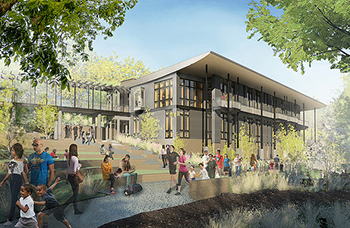Frick Environmental Center to Offer Sustainable Education
 PITTSBURGH — In a lush 644-acre Pittsburgh park, one of the most environmentally friendly buildings in the world is being constructed.
PITTSBURGH — In a lush 644-acre Pittsburgh park, one of the most environmentally friendly buildings in the world is being constructed.
Set in Frick Park, the new 15,500-square-foot Frick Environmental Center, which began its first phase of construction last month, has been designed to meet strict standards for both LEED Platinum certification and the Living Building Challenge. The Living Building Challenge requires building projects to operate cleanly and efficiently, and the environmental center aims to do that with little impact on its surrounding woodlands.
“The center itself is designed to not only be one of the greenest buildings on earth, but to inspire visitors to make choices in their own lives that support environmental and human health,” Pittsburgh Parks Conservancy Director of Education Marijke Hecht said in a statement.
The new center, which will provide environmental education to K-12 students, is a project of the Pittsburgh Parks Conservancy in partnership with the city of Pittsburgh. When finished, the sustainable facility will completely support its own needs for water and energy and will function at net zero energy and net zero water levels by incorporating things such as a ground-source geothermal heating and cooling system; a natural ventilation system; solar panels; and a rainwater collection and irrigation system that includes the use of canopies and permeable pavement in portions of the parking area. Rainwater collected from the center’s roof will be directed to fall in a water curtain, allowing visitors to look out through a veil of rain during downpours. The water will then be directed into the site’s water management system.
That reclaimed rainwater will be used for flushing toilets and irrigation purposes. A wetland zone south of the building will absorb overflow from the rainwater harvesting system. Additionally, all waste water will be filtered and treated on-site before it is released naturally on-site.
When completed, the new space — which incorporates locally produced materials — will include indoor learning spaces, a public gathering and reception area, public restrooms and offices, as well as an amphitheater built into a hillside. Two historic gatehouses will be restored, and construction includes a formal entrance landscape, demonstration gardens and the planting of more than 195 trees and 7,000 native plants. An on-site fountain restoration will help with water conservation, and designers are including an interactive pumping system that visitors can control.
“We have designed the new Environmental Center with the goal of creating both a classroom base and a year-round community gathering point for programming that takes people of all ages out into the surrounding woods, streams, meadows and trails of Frick Park,” Pittsburgh Parks Conservancy Founder and CEO Meg Cheever said in a statement. “Our current programming is full to capacity, and the new space will enable us to introduce more children to the beauty and wonder of nature, and to grow our work in providing STEM-based K-12 science curriculum that takes children out of the classroom into the living laboratory of Frick Park.”
